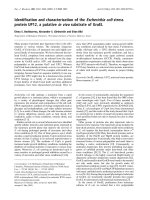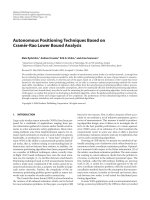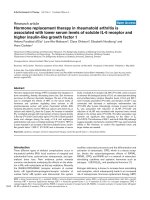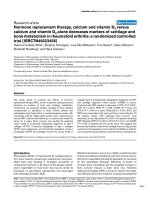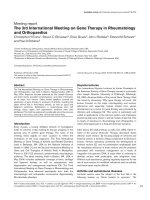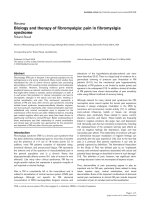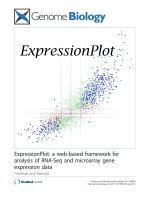Báo cáo y học: "Goal-directed intraoperative therapy based on autocalibrated arterial pressure waveform analysis reduces hospital stay in high-risk surgical patients: a randomized, controlled trial" pot
Bạn đang xem bản rút gọn của tài liệu. Xem và tải ngay bản đầy đủ của tài liệu tại đây (511.66 KB, 9 trang )
RESEARC H Open Access
Goal-directed intraoperative therapy based on
autocalibrated arterial pressure waveform analysis
reduces hospital stay in high-risk surgical
patients: a randomized, controlled trial
Jochen Mayer
*
, Joachim Boldt, Andinet M Mengistu, Kerstin D Röhm, Stefan Suttner
Abstract
Introduction: Several studies have shown that goal-directed hemodynamic and fluid optimization may result in
improved outcome. However, the methods used were either invasive or had other limitations. The aim of this
study was to perform intraoperative goal-directed therapy with a minimally invasive, easy to use device (FloTrac/
Vigileo), and to evaluate possible improvements in patient outcome determined by the duration of hospital stay
and the incidence of complications compared to a standard management protocol.
Methods: In this randomized, controlled trial 60 high-risk patients scheduled for major abdominal surgery were
included. Patients were allocated into either an enhanced hemodynamic monitoring group using a cardiac index
based intraoperative optimization protocol (FloTrac/Vigileo device, GDT-gr oup, n = 30) or a standard management
group (Control-group, n = 30), based on standard monitoring data.
Results: The median duration of hospital stay was significantly reduced in the GDT-group with 15 (12 - 17.75) days
versus 19 (14 - 23.5) days (P = 0.006) and fewer patients developed complications than in the Control-group [6
patients (20%) versus 15 patients (50%), P = 0.03]. The total number of complications was reduced in the GDT-
group (17 versus 49 complications, P = 0.001).
Conclusions: In high-risk patients undergoing major abdominal surgery, implementation of an intraoperative goal-
directed hemodynamic optimization protocol using the FloTrac/Vigileo device was associated with a reduced
length of hospital stay and a lower incidence of complications compared to a standard management protocol.
Trial Registration: Clinical trial registration information: Unique identifier: NCT00549419
Introduction
There is growing evidence that perioper ative goal-direc-
ted therapy (GDT) based on flow-related hemodynamic
parameters im proves patient outcome [1,2], particularly
in high- risk patients [3,4]. Mean arterial blood pressure
(MAP) and central venous pressure (CVP) are routinely
used to monitor hemodynamics, but no information on
blood flow can be obtained with MAP and CVP. There-
fore, enhanced hemodynamic monitoring seems to b e
crucial in the guidance of perioperative volume therapy
and cardiocirculatory support. Previous optimization
studies vary largely with regard to study design and the
complexity of the monitoring technique used. Most of
the trials used the pulmonary artery catheter (PAC)
[5-8] and the esophagus Doppler (ED) method [9-11].
These methods are either highly invasive (PAC) or show
limited accuracy (ED) [12] combined with other disad-
vantages such as frequent dislocation of the ultrasound
probe [13] or poor toleration in awake patients [14].
In the present study, we used the FloTrac/Vigileo, a
minimally invasive device, which only needs standard
arterial access for enhanced, flow-based hemodynamic
monitoring. The device is reported to be easy to use
and easy to set up [15] and calculates the stroke volume
on the basis of the arterial waveform in combination
* Correspondence:
Department of Anesthesiology and Intensive Care Medicine, Klinikum
Ludwigshafen, Bremserstrasse, 79, 67063 Ludwigshafen, Germany
Mayer et al. Critical Care 2010, 14:R18
/>© 2010 Mayer et al.; licensee BioMed Central Ltd. This is an open access article distributed under the terms of the Creative Commons
Attribu tion License ( which permits unr estricted use, distribution, and reproduction in
any medium, provided the original work is properly cite d.
with demographic data. Recent studies have shown a
good agreement compared with more invasive methods
to determine cardiac output (CO) [16-19]. In this study
we aimed to determine whether an intraoperative opti-
mization protocol using the enhanced flow-based hemo-
dynamic parameters of the FloTrac/Vigileo device would
result in an improvement in outcome in high-risk
patients undergoing major abdominal surgery, measured
by the length of hospital stay (LOS) compared with a
standard protocol based on conventional hemodynamic
data.
Materials and methods
After obtaining written informed consent and I nstitu-
tional Review Board approval, 60 patients with an
American Society of Anesthesiologists (ASA) physical
status (Table 1) [20] of III with two or more risk factors
according to risk index of Lee (Table 2) [21] undergoing
open major abdominal surgery (intestine resection, gas-
tric resection , liver resection, esophageal resection,
Whipple) were studied between 18 J anuar y 2008 and 16
March 2009. Patients under 18 years, patients with
severe aortic regurgitation, permanent cardiac arrhyth-
mias, intra-ao rtic balloon pump and patients undergoing
emergency surgery were excluded from the study.
The study was a single-centre, prospective randomized
trial carried out in a tertiary, university affiliated hospital.
Patients were randomized preoperatively either into a
standard proto col group (control group) or an enhanced,
goal-directed hemodynamic monitoring group (GDT
group) using a closed envelope system. Randomization
was performed by a member of the research team.
In both groups, premedication consisted of midazolam
(0.01 mg kg
-1
), and standard general anesthesia was
induced with fentanyl 1 to 2 μgkg
-1
,propofol1.5to
2mgkg
-1
and cisatracrurium 0.07 mg kg
-1
.Afterintu-
bation of the trachea, the lungs were ventilated to main-
tain normocapnia (end expiratory partial pressure of
carbon dioxide level 32 to 38 mmHg) using a constant
fresh g as flow of 1 L min
-1
. Maintenance of anesthesia
was performed with 0.9 to 1.8% end tidal sevoflurane,
and fentanyl and cisatracrurium boli were given as
needed. Standard monitoring for both groups included
electrocardiogram, invasive arterial blood pressure via
right or left radial artery, CVP, pulse oximetry, tempera-
ture, inspiratory and expiratory gas concentrations.
In the control group, MAP was kept between 65 and 90
mmHg, CVP between 8 and 12 mmHg and urinary out-
put more than 0.5 mL kg
-1
h
-1
. The GDT-group patie nts
received enhanced hemodynamic monitoring with the
FloTrac/Vigileo device (Edwards Lifesciences, Irvine, CA,
USA) and an attempted cardiac index (CI) of a t least 2.5
L·min
-1
·m
-2
. The arterial line was connected to the Vigi-
leo monitor (software version 1.14; Edwards Lifesciences,
Irvine, CA, USA) via the FloTrac pressure transducer and
all intravascular pressure measurem ents were referenced
to mid-axillary line level. The shape of the arterial curve
was checked visually for damping throughout the study
period. CI, stroke volume index (SVI), as an indicator for
fluid status, and stroke volume variation, (SVV) as an
indicator for fluid responsiveness during mechanical ven-
tilation and sinus rhythm, werecontinuouslymeasured.
Details of the protocols for both standard and enhanced
hemodynamic monitoring are summarized in Figures 1
and 2. Side effects of GDT (e.g. tachycardia during dobu-
tamine infusion) were not acceptable and as soon as they
developed further optimization attempts wer e ceased and
patients were kept at the best possible level. Blood loss
was substituted with fluids acco rding to the protocols
and a hemogl obin value below 8 mg dL
-1
was considered
to be a trigger for transfusion of packed red blood cells.
The respective protocols in both groups were contin-
ued until the transportatio n monitoring equipment was
attached to the patients, which happened after the end
of surgery and hemodynamic stability. All patients were
admitted to the intensive careunit(ICU)andboth
groups were managed by the same physicians on the
same wards (ICU and general ward) who were not
involved in the intraoperative management, data collec-
tion or group allocation of the study. Complications
were assessed daily by senior anesthesiologists and
senior surgeons blinded to group allocation and study
design using standard predefined criteria. All data were
collected by a study nurse blinded to the study design
and group allocation, except vital data, which were
Table 1 The American Society of Anesthesiologists (ASA)
physical status
ASA physical
status
Description
I A normal healthy patient
II A patient with mild systemic disease
III A patient with severe systemic disease
IV A patient with severe systemic disease that is a
constant threat to life
V A moribund patient who is not expected to survive
without the operation
Table 2 The revised Lee cardiac risk index
1. High-risk type of surgery
2. Ischemic heart disease
3. History of congestive heart failure
4. History of cerebrovascular disease
5. Insulin therapy for diabetes
6. Preoperative serum creatinine > 2.0 mg/dl
Mayer et al. Critical Care 2010, 14:R18
/>Page 2 of 9
collected automatically using custom PC soft ware (Nar-
koData, Imeso, Hüttenberg, Germany).
To ascertain comparable preconditions between the
groups with respect to preoperative co-mo rbidity and
type of surgery, all patients underwent POSSUM (phy-
siological and operative severity score for the enumera-
tion of mortality and morbidity) scoring [22].
Patients were ready for hospital discharge when they
showed stable cardiovascular and respira tory conditions,
ability to take oral fluids, sufficient pain control, mobili-
zation (as far as possible), spontaneous micturition,
infection parame ters within normal range, consciousness
comparable with the preoperative state and non-irritated
wound conditio ns. These criteria were classified by spe-
cialist surgeons, wh o where not involved in the study
design or group allocation.
Statistical analysis
Theprimaryoutcomevariablewasthedurationofhos-
pital stay. Secondary outcome variables were the inci-
dence of p erioperative complications, the duration of
the ICU stay, the amount and type of fluids used intrao-
peratively, and the amount and type of vasoactive and
positive inotropic support used intraoperatively.
A MedCalc 4.31 software package (MedCal c Software,
Mariakerke, Belgium) was used for statistical analyses.
The number of patients required in each group was
determined before the study by a power calculation
based on the results of a similar previous study [1]. It
was found that the minimum clinically important differ-
ence we wished to detect was a 20% decrease in the pri-
mary endpo int duration of hospital stay. With an
assumed a error of 0.05 (two-sided) and type II error of
0.2,wefound24patientspergrouptoberequired.To
compensate for possible dropouts, we decided to include
30 patients per group.
The assumption of normality was checked using the
Kolmogorov-Smirnov test. Continuous, normally distrib-
uted data were compared using paired and unpaired
Student’s t-test and a Bonferroni correction for repeated
measurements was applied. Continuous, non-normally
distributeddatawerecomparedusingtheWilcoxon
test. Binominal data were compared using chi-squared
analysis and Fisher’s exact test. All tests were two-sided
and were performed at a corrected a = 0.05 level unless
otherwise specified.
Results
The patient flow through the study is shown in Figure 3.
Both groups were comparable with respect to age, gen-
der, weight, co-morbidities and the type of surgery as
determined by the Lee classification scheme (Table 2)
Figure 1 Enhanced hemodynamic monitoring protocol with FloTrac/Vigileo. CI, cardiac index; MAP, mean arterial pressure; SVI, stroke
volume index; SVV, stroke volume variation.
Mayer et al. Critical Care 2010, 14:R18
/>Page 3 of 9
[21] and the POSSUM score [22] (Table 3). Anesthetic
requirements and duration of surgery also did not differ
between the groups (Table 4). In the GDT group, we
found a reduced median (interquartile range) duration
of hospital stay of 15 (12 to 17.75) days versus 19 (14 to
23.5; P = 0.006; Figure 4) in the control group. The
number of patients who developed co mplications was
lower in the GDT group (6 patients, 20%) than in the
control group (15 patients, 50%; P = 0.03) and fewer
complications per group were doc umented in th e GDT
group (17 complications) than in the control group (49
complications; P = 0.001; Table 5). No difference was
found between the groups in the duration of ICU stay
(39.6 ± 39.5 hours in the GDT group vs. 41.9 ± 43.5
hours in the control group; P = 0.70) and postoperative
mechanical ventilation (4.8 ± 4.5 hours in the GDT
group vs. 7.8 ± 10.0 hours in the control group; P =
0.14). Significantly more colloids were administered in
the GDT group (1188 ± 550 ml vs. 817 ± 467 ml; P =
0.006), whereas the amount of crystalloid volume repla-
cement was lower (2489 ± 80 5 ml vs. 3153 ± 1264 ml;
P = 0.02). The total amount of fluids administered
Figure 2 Standard care protocol. MAP, mean arterial pressure; CVP, central venous pressure.
Mayer et al. Critical Care 2010, 14:R18
/>Page 4 of 9
intraoperatively (including packed red blood cells and
fresh frozen plasma) was not different between the
groups (4528 ± 2317 ml vs. 4494 ± 1561 ml). Positive
inotropic support with dobutamine was higher in the
GDT group (30.4 ± 50.5 μgkg
-1
h
-2
vs. 4.1 ± 19.0 μg
kg
-1
h
-2
; P = 0.01). Administration of norepinephrine,
epinephrine and nitrates was similar between the
groups. No difference was found with regard to urinary
output, loss of blood and blood transfusion. One patient
in the GDT group did not achieve the predefined goals
and optimization attempts were ceased because of
tachyarrhythmia with a CI around 2.2 L·min
-1
·m
-2
.All
patients of t he control group achieved the predefined
goals. Two postoperative deaths occurred in each gro up.
In each group, one patient died second ary to anastomo-
tic leakage and sepsis. In one patien t of the control
group, myocardial infarction was diagnosed leading to
fatal cardiogenic shock. One patient of the intervention
group developed massive intraabdominal bleeding,
which was f atal before emergency re-laparotomy could
be performed.
Two patients in each group were actually discharged
two days later than possible because of social reasons.
Discussion
Intraoperative GDT based o n minimally invasive, flow-
related parameters obtain ed by autocalibrated arterial
waveform analysis resulted in a signifi cant reduction in
Figure 3 Patient flow throughout the study.
Mayer et al. Critical Care 2010, 14:R18
/>Page 5 of 9
Table 4 Intraoperative data, hemodynamics and volume
replacement
GDT group
n=30
Control
group
n=30
P
Duration of anesthesia (min) 357 ± 92 365 ± 113 0.75
Surgery time (min) 280 ± 84 297 ± 109 0.51
Urinary output (ml·kg
-1
·h
-1
) 2.2 ± 1.5 1.6 ± 1.6 0.16
Blood loss (ml) 1090 ± 1385 892 ± 747 0.49
Intraoperative hemodynamics
#
Heart rate (bpm) 69 ± 15 70 ± 16 0.31
MAP (mmHg) 80.6 ± 16.1 74.6 ± 15.5 0.006*
CVP (mmHg) 12 ± 5 10 ± 4 0.01*
SVI (ml m
-2
) 38.8 ± 9.1 - -
SVRI (dyne·s·cm
-5
·m
-2
) 2101 ± 459 - -
CI (L·min
-1
·m
-2
) 2.7 ± 0.8 - -
Crystalloid volume replacement (ml) 2489 ± 805 3153 ± 1264 0.02*
Colloid volume replacement (ml) 1188 ± 550 817 ± 467 0.006*
PRBC (ml·kg
-1
·h
-2
) 1.3 ± 1.8 0.9 ± 1.0 0.28
FFP (ml·kg
-1
·h
-2
) 0.5 ± 1.3 0.2 ± 1.6 0.35
Total volume infused
intraoperatively (ml)
4528 ± 2317 4494 ± 1561 0.95
#, mean of values taken automatically every five minutes; * significant; bpm,
beats per minute; CI, cardiac index; CVP, central venous pressure; GDT, goal-
directed therapy; FFP, fresh frozen plasma; MAP, mean arterial pressure; PRBC,
packed red blood cells; SVI, stroke volume index; SVRI, systemic vascular
resistance index. All data presented as mean ± standard deviation.
Table 3 Demographic and preoperative data
GDT group
n=30
Control group
n=30
Gender (m/f) 20/10 22/8
Age (years) 73 (69-78) 72 (68-78)
Body mass Index (kg·m
-2
) 25.8 ± 3.8 26.4 ± 5.5
POSSUM score
Physiology 22 (19-25) 21 (19-27)
Operation 17 (15-22) 19 (15-21)
Surgical procedure
Hemicolectomy 10 11
Gastrectomy 10 5
Rectum resection 3 9
Whipple 5 2
Esophagus resection 1 1
Liver resection 1 2
Pre-existing conditions
Ischemic heart disease 20 18
Cerebrovascular disease 6 5
Diabetes mellitus requiring
insulin
22
Hypertension 27 28
Obstructive pulmonary disease 3 4
Peripheral vascular disease 4 4
Renal failure requiring dialysis 0 0
Renal failure without dialysis 6 5
All data presented as mean ± standard deviation, except age and POSSUM
score values (median (interquartile range)). GDT, goal-directed therapy; f,
female; m, male; POSSUM, physiological and operative severity score for the
enumeration of mortality and morbidity [22].
Figure 4 Kaplan-Meier survival analysis of length of hospital stay. The dotted line represents the goal-directed therapy (GDT) group.
Mayer et al. Critical Care 2010, 14:R18
/>Page 6 of 9
LOS and significantly less perioperative complications
compared with a standard management protocol with
pressure-based target parameters.
The first evidence that flow-based cardiovascular para-
meters such as CO or oxygen delivery index (DO
2
I) cor-
relate with the outcome in high-risk patients or high-
risk surgery was shown by Shoemaker and colleagues
[23,24]. Although these studies remained controversial,
subsequent work confirmed that goal-directed protocols
for perioperative management using flow-related para-
meters improve patient outcome [1-3,5-8,25,26]. The
underlying mechanisms of the suc cess of GDT are not
yet entirely clear. Most authors assume that an oxygen
debt from decreased blood flow, hypoxia or hypovolemia
may cause mitochondrial damage and subsequent organ
dysfunction [27]. Thus, adequate tissue oxygen supply
seemstoplayakeyroletopreventadversepatientout-
come. Although blood flow to peripheral tissues is diffi-
cult to measure, tissue oxygen supply may be
approximated using the DO
2
I. However, the DO
2
I needs
to be calculated from information pro vided by repeated
blood gas analyses. We therefore d ecided to use the CI
as the target variable of the GDT protocol in this study,
because this variable can be easily obtained and continu-
ously measured with the arterial waveform analysis
method in a busy intraoperative setting. Together with
adequate hemoglobin lev els and arterial oxygen satura-
tion, we considered the CI as an adequate target for
flow-based GDT.
The results of this study are in good agreement with
previous tria ls dealing with goal-directed hemodynamic
optimization ba sed on flow-related parameters, although
target variables and methods to achieve the goals vary
widely in the literature. Lithium indicator dilution was
use d by Pearse and colleagues [1] to determine CO and
DO
2
I in patients undergoing major abdominal surgery.
In this study, patients in the intervention group were
optimized postoperat ively with colloids and dopexamine
toachieveaDO
2
I of 600 ml min
-1
m
-2
. A significant
reduction in LOS from 29.5 days to 17.5 days and in the
number of patients with complications (69% vs. 44%)
were found in comparison to a CVP-based protocol in a
standard care group. POSSUM score values and surgical
interventions were comparable with the present study,
Table 5 Complications until hospital discharge
Complication Diagnostic tools GDT
group
n=30
Control
group
n=30
Infection
Pneumonia Confirmed chest x-ray, WBC > 12 × 10
3
or<4×10
3
ml
-1
13
Abdominal Abdominal CT 1 4
Urinary tract Dysuria, urine analysis 0 0
Wound Clinical diagnosis 3 8
Respiratory
Pulmonary embolism CTPA 0 0
Respiratory support > 24 hours or weaning failure NIV > 24 hours, Re-intubation 2 3
Cardiovascular
Pulmonary edema Auscultation, chest x-ray 0 2
Arrhythmia ≥ Lown II, ≥ 30 atrial extrasystoles, AF, VF 2 3
Hypotension Mean arterial pressure ≤ 50 mmHg 2 9
Acute myocardial infarction ECG signs for ischemia, troponin T ≥ 0.03 ng ml
-1
02
Stroke Clinical diagnosis confirmed with CCT 0 1
Abdominal
Bowel obstruction No defecation > 4 days 1 2
Upper gastro-intestinal bleeding Clinical diagnosis, confirmed with endoscopy 1 0
Anastomotic leak Drainage discharge, abdominal CT, WBC > 12 × 10
3
or<4×10
3
ml
-1
13
Renal
Urine output < 500 ml/day or required dialysis for
acute renal failure
Clinical diagnosis 1 5
Post-operative massive hemorrhage > 300 ml h
-1
and/or need of re-operation 0 2
Perioperative deaths 22
Total number of complications 17 49
Number (percentage) of patients with complications 6 (20%) 15 (50%)
AF, atrial fibrillation; CCT, cran ial computed tomography;CT, computed tomography; CTPA, computed tomography pulmonary angiogram; ECG, electrocardiogram;
GDT, goal-directed therapy; NIV, non invasive ventilation; VF, ventricular flutter; WBC, white blood cell count.
Mayer et al. Critical Care 2010, 14:R18
/>Page 7 of 9
but Pearse and colleagues initiated their optimization
protocol lat er with admission to ICU. The Lithium dilu-
tion cardiac output (L iDCO) method was used, which is
considered more invasive and complicated than autocali-
brated arterial waveform analysis because frequent man-
ual recalibrations are required [28] and an artificial
indicator limits the number of calibrati ons per day [29].
Lopes and colleagues [25] an alyzed the effects of intrao-
perative o ptimization of pulse pressure variation (PPV).
PPV was kept below 10% with colloid boluses in the
intervention group and a significant reduction in LOS
(from 17 to 7 days) and complications (75% of the
patients vs. 41% of the patients) was found. In contrast
to the present study, no protocol for the control group
existed and PPV was the only parameter to guide opti-
mization. Several previous studies used ED as t he GDT,
but were mostly limited to fluid optimization [19,10,11].
Noblett and colle agues [11] investigated the effects of
ED-guided intraoperative colloid fluid resuscitation in
patients undergoing colorectal resection and found a
reduced LOS (nine vs. six days) and a reduced compl i-
cation rate. The median POSSUM scores, however, were
lower in this study (exp laining the shorter LOS), admin-
istration of inotropes was n ot part of the optimization
protocol and no protocol for the standard care group
existed. The role o f the ED method in goal-direc ted
fluid therapy was investigated in a meta-analysis by
Abbas and Hill [26] and an overall reduction of L OS
and lower complication rates were found in the GDT
groups of five studies, although absolute CO measure-
ments were found to be imprecise [12].
In the present stu dy, the amount of colloids adminis-
tered in the GDT group was significantly higher and the
amount of crystalloids was lower, which could have
been protocol dependant. However, this finding is con-
sistent with findings in other GDT literature, where a
trend towards a more generous administra tion of col-
loids instead of crystalloids can be seen [1,2,25,30] and
may be most likely a result of an earlier detection of
fluid demand with enhanced hemodynamic monitoring.
Kimberger and colleagues [31] recently investigated the
influence of different volume regimens on tissue perfu-
sion in an animal model and found a significantly
increased microcirculatory blood flow and tissue oxygen
tension with goal-directed administ ration of colloids.
The ongoing discussion about the ‘opti mal’ amount and
type of fluid can at least partially be resolv ed, as e vi-
dence grows that individually titrated, goal-directed
administration of primarily colloid solutions im proves
patient outcome in patients undergoing major abdom-
inal surgery [2,25,32].
Permanent cardiac arrhythmias are a problem that
affects almost all methods to determine flow-based
hemodynamic variables, in particular those using the
arterial waveform as source of information. The preci-
sion becomes less accurate and determination of SVV is
not possible. Although temporary, short arrhythmi c epi-
sodes can be eliminated by the algor ithm of the Vig ileo
device, episodes shorter than five minutes were elimi-
nated by c easing measurements during this time. We
also had to exclude patients with permanent cardiac
arrhythmias, which might be a limitation of this study.
It has also been found that the bolus administration of
vasoactive drugs m ay affect accuracy of the arte rial
waveform-based method [33]. However, bolus admin is-
tration was rarely necessary and measurements were dis-
continued during this period. Furthermore, the study is
underpowered to analyze mortality and patient follow-
up was performed until hospital discharge only.
Conclusions
The results of this study demonstrated that an optimiza-
tion protocol based on flow-related hemodynamic para-
meters obtained with the minimally invasive FloTrac/
Vigileo device reduced the duration of hospital stay and
perioperative complications in high-risk patients under-
going major abdominal surgery.
Key messages
• Intraoperative GDT using a protocol based on
enhanced hemodynamic variables derived by the Flo-
Trac/Vigileo device reduced the LOS in high-risk
patients undergoing major abdominal surgery com-
pared with a standard management protocol.
• The incidence of complications was reduced in th e
enhanced monitoring group.
• No difference between the standard and enhanced
monitoring protocol groups was found with regard
to ICU stay.
Abbreviations
ASA: American Society of Anesthesiology; CI: cardiac index; CO: cardiac
output; CVP: central venous pressure; DO
2
I: oxygen delivery index; ED:
esophagus Doppler; GDT: goal-directed therapy; ICU: intensive care unit;
LiDCO: lithium dilution cardiac output; LOS: length of hospital stay; MAP:
mean arterial pressure; PAC: pulmonary artery catheter; POSSUM:
physiological and operative severity score for the enumeration of mortality
and morbidity; PPV: pulse pressure variation; SVI: stroke volume index; SVV:
stroke volume variation.
Acknowledgements
This study was funded by an unrestricted grant by Edwards Lifesciences,
Irvine, CA, USA. The authors thank Heide-Rose Mörschel for help with data
acquisition and Matthias Rothenbacher for creating the flow charts.
Authors’ contributions
JM and SS conceived and designed the study, performed the statistical data
analysis and drafted the manuscript. JM and JB were responsible for patient
recruitment. AM and KR participated in data acquisition. All authors read and
approved the final manuscript.
Competing interests
JM and JB received speaking fees from Edwards Lifesciences, Irvine, CA, USA.
Mayer et al. Critical Care 2010, 14:R18
/>Page 8 of 9
Received: 8 October 2009 Revised: 11 January 2010
Accepted: 15 February 2010 Published: 15 February 2010
References
1. Pearse R, Dawson D, Fawcett J, Rhodes A, Grounds RM, Bennet ED: Early
goal-directed therapy after major surgery reduces complications and
hospital stay. A randomised, controlled trial. Crit Care 2005, 9:R687-R693.
2. Bundgaard-Nielsen M, Holte K, Secher NH, Kehlet H: Monitoring of peri-
operative fluid administration by individualized goal-directed therapy.
Acta Anaesthesiol Scand 2007, 51:331-340.
3. Donati A, Loggi S, Preiser JC, Orsetti G, Münch C, Gabbanelli V, Pelaia P,
Pietropaoli P: Goal-directed intraoperative therapy reduces morbidity and
length of hospital stay in high-risk surgical patients. Chest 2007,
132:1817-1824.
4. Giglio MT, Marucci M, Testini M, Brienza N: Goal-directed haemodynamic
therapy and gastrointestinal complications in major surgery: a meta-
analysis of randomized controlled trials. Br J Anaesth 2009, 103:637-646.
5. Boyd O, Grounds RM, Bennett ED: A randomized clinical trial of the effect
of deliberate perioperative increase of oxygen delivery on mortality in
high-risk surgical patients. JAMA 1993, 270:2699-2707.
6. Harvey S, Harrison DA, Singer M, Ashcroft J, Jones CM, Elbourne D,
Brampton W, Williams D, Young D, Rowan K, PAC-Man study collaboration:
Assessment of the clinical effectiveness of pulmonary artery catheters in
management of patients in intensive care (PAC-Man): a randomized
controlled trial. Lancet 2005, 366:472-477.
7. Wilson J, Woods I, Fawcett J, Whall R, Dibb W, Morris C, McManus E:
Reducing the risk of major elective surgery: randomised controlled trial of
preoperative optimisation of oxygen delivery. BMJ 1999, 318:1099-1103.
8. Lobo SM, Salgado PF, Castillo VG, Borim AA, Polachini CA, Palchetti JC,
Brienzi SL, de Oliveira GG: Effects of maximizing oxygen delivery on
morbidity and mortality in high-risk surgical patients. Crit Care Med 2000,
28:3396-3404.
9. Conway DH, Mayall R, Abdul-Latif MS, Gilligan S, Tackaberry C: Randomized
controlled clinical trial investigating the influence of intravenous fluid
titration using oesophageal Doppler monitoring during bowel surgery.
Anaesthesia 2002, 57:845-849.
10. Gan TJ, Soppitt A, Maroof M, el-Moalem H, Robertson KM, Moretti E,
Dwane P, Glass PS: Goal-directed intraoperative fluid administration
reduces length of hospital stay after major surgery. Anesthesiology 2002,
97:820-826.
11. Noblett SE, Snowden CP, Shenton BK, Horgan AF: Randomized clinical trial
assessing the effect of Doppler-optimized fluid management on
outcome after elective colorectal resection. Br J Surg 2006, 93:1069-1076.
12. Dark PM, Singer M: The validity of trans-esophageal doppler
ultrasonography as a measure of cardiac output in critically ill adults.
Intensive Care Med 2004, 30:2060-2066.
13. Lefrant JY, Bruelle P, Aya AG, Saïssi G, Dauzat M, de La Coussaye JE,
Eledjam JJ: Training is required to improve the reliability of esophageal
doppler to measure cardiac output in critically ill patients. Intensive Care
Med 1998, 24:347-352.
14. Jaeggi P, Hofer CK, Klaghofer R, Fodor P, Genoni M, Zollinger A:
Measurement of cardiac output after cardiac surgery by a new
transesophageal Doppler device. J Cardiothorac Vasc Anesth 2003,
17:217-220.
15. Manecke GR: Cardiac output from the arterial catheter: deceptively
simple. J Cardiothorac Vasc Anesth 2007, 21:629-631.
16. Mayer J, Boldt J, Wolf MW, Lang J, Suttner S: Cardiac output derived from
arterial pressure waveform analysis in patients undergoing cardiac
surgery: validity of a second generation device. Anesth Analg 2008,
106:867-872.
17. Prasser C, Trabold B, Schwab A, Keyl C, Ziegler S, Wiesenack C: Evaluation
of an improved algorithm for arterial pressure-based cardiac output
assessment without external calibration. Intensive Care Med 2007,
33:2223-2225.
18. Mayer J, Boldt J, Beschmann R, Stephan A, Suttner S: Uncalibrated arterial
pressure waveform analysis for less-invasive cardiac output
determination in obese patients undergoing cardiac surgery. Br J
Anaesth 2009, 103:185-190.
19. Hofer CK, Senn A, Weibel L, Zollinger A: Assessment of stroke volume
variation for prediction of fluid responsiveness using the modified
FloTrac and PiCCOplus system. Crit Care 2008, 12:R82.
20. ASA physical status classification system. [ />physicalstatus.htm].
21. Lee TH, Marcantonio ER, Mangione CM, Thomas EJ, Polanczyk CA, Cook EF,
Sugarbaker DJ, Donaldson MC, Poss R, Ho KK, Ludwig LE, Pedan A,
Goldman L: Derivation and prospective validation of a simple index for
prediciton of cardiac risk of major noncardiac surgery. Circulation 1999,
100:1043-1049.
22. Copeland GP: The POSSUM system of surgical audit. Arch Surg 2002,
137:15-19.
23. Shoemaker WC: Cardiorespiratory patterns of surviving and nonsurviving
postoperative patients. Surg Gynecol Obstet 1972, 134:810-814.
24. Shoemaker WC, Appel PL, Kram HB, Waxman K, Lee TS: Prospective trial of
supranormal values of survivors as therapeutic goals in high-risk surgical
patients. Chest 1988, 94:1176-1186.
25. Lopes MR, Oliveira MA, Pereira VO, Lemos IP, Auler JO Jr, Michard F: Goal-
directed fluid management based on pulse pressure variation
monitoring during high-risk surgery: a pilot randomized controlled trial.
Crit Care 2007, 11:R100.
26. Abbas SM, Hill AG: Systematic review of the literature for the use of
oesophageal Doppler monitor for fluid replacement in major abdominal
surgery. Anaesthesia 2008, 63:44-51.
27. Poeze M, Greve JW, Ramsay G: Meta-analysis of hemodynamic
optimization: relationship to methodological quality. Crit Care 2005, 9:
R771-779.
28. Cecconi M, Dawson D, Grounds RM, Rhodes A: Lithium dilution cardiac
output measurement in the critically ill patient: determination of
precision of the technique. Intensive Care Med 2009, 35:498-504.
29. Costa MG, Della Rocca G, Chiarandini P, Mattelig S, Pompei L, Sainz
Barriga M, Reynolds T, Cecconi M, Pietropaoli P: Continuous and
intermittent cardiac output measurement in hyperdynamic conditions:
pulmonary artery catheter vs. lithium dilution technique. Intensive Care
Med 2008, 34:257-263.
30. Wakeling HG, McFall MR, Jenkins CS, Woods WG, Miles WF, Barclay GR,
Fleming SC: Intraoperative oesophageal Doppler guided fluid
management shortens postoperative hospital stay after major bowel
surgery. Br J Anaesth 2005, 95:634-642.
31. Kimberger O, Arnberger M, Brandt S, Plock J, Sigurdsson GH, Kurz A,
Hiltebrand L: Goal-directed colloid administration improves the
microcirculation of healthy and perianastomotic colon. Anesthesiology
2009, 110:496-504.
32. Spahn DR, Chassot PG: CON: Fluid restriction for cardiac patients during
major noncardiac surgery should be replaced by goal-directed
intravascular fluid administration. Anesth Analg 2006, 102:344-346.
33. Eleftheriadis S, Galatoudis Z, Didilis V, Bougioukas I, Schön J, Heinze H,
Berger KU, Heringlake M: Variations in arterial blood pressure are
associated with parallel changes in FlowTrac/Vigileo®-derived cardiac
output measurements: a prospective comparison study. Crit Care 2009,
13:R179.
doi:10.1186/cc8875
Cite this article as: Mayer et al.: Goal-directed intraoperative therapy
based on autocalibrated arterial pressure waveform analysis reduces
hospital stay in high-risk surgical patients: a randomized, controlled
trial. Critical Care 2010 14:R18.
Submit your next manuscript to BioMed Central
and take full advantage of:
• Convenient online submission
• Thorough peer review
• No space constraints or color figure charges
• Immediate publication on acceptance
• Inclusion in PubMed, CAS, Scopus and Google Scholar
• Research which is freely available for redistribution
Submit your manuscript at
www.biomedcentral.com/submit
Mayer et al. Critical Care 2010, 14:R18
/>Page 9 of 9
